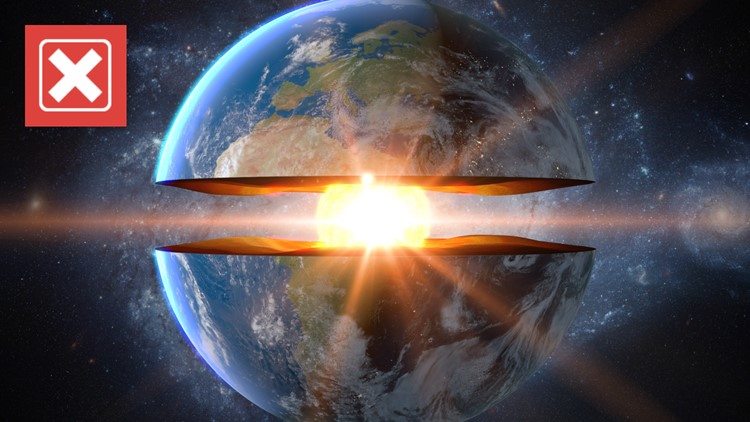A 2003 film titled The Core depicted a scenario in which disasters happened across the Earth because the planet’s core stopped spinning. Could this now be happening in real life?
Some people are claiming a recent study suggests we’re about to find out. Viral tweets say a “new study claims Earth’s core has stopped and may be reversing in direction” and “Earth’s spinning inner core recently paused then flipped its direction.”
One VERIFY reader texted us to ask: “Has the inner core of Earth reversed its direction recently? How does that affect us? What happens next?”
THE QUESTION
Did a recent study find the Earth’s inner core reversed direction?
THE SOURCES
Original study published in Nature Geoscience on Jan. 23, 2023
Xiaodong Song, Ph.D., co-author of Jan. 23 study and other studies of the core’s rotation
John Vidale, Ph.D., co-author of other studies about the core’s rotation
Nature, parent company of Nature Geoscience
THE ANSWER
No, a recent study did not find the Earth’s inner core reversed direction.
WHAT WE FOUND
A study didn’t find the Earth’s core stopped spinning or reversed direction. Instead, the study suggests the Earth’s inner core — which spins independently of the rest of Earth — slowed down, and the core slows down and then speeds up on a regular cycle.
The Earth’s inner core is a ball of solid iron about as hot as the surface of the sun. It’s surrounded by a layer of liquid metal called the outer core, the National Center for Families Learning says. This layer of liquid metal separates the inner core from the rest of the planet, making it possible for the core to rotate at a different speed than the surface, Science Magazine and Nature, the publisher of the study, says.
In the study, published in Nature Geoscience on Jan. 23, 2023, two scientists from Peking University in China used past earthquake data to find the Earth’s inner core was rotating faster than the Earth’s surface, but has since slowed to the point of matching the surface’s rotation speed. They believe that the core will now begin to rotate slower than the surface, and that the core’s rotation speed changes on a 70-year cycle.
According to the scientists, the inner core rotates faster than the Earth's surface for about half the cycle, and slower during the other half. While the inner core is transitioning between its faster and slower phases, the inner core rotates at about the same speed as the rest of the Earth.
The core “pausing” or “turning back,” terms used in the study’s abstract, refers to the core’s position relative to a point on the surface, which is constantly rotating. The authors of the study issued an update on Jan. 31 to clarify this.
“Some language in this article has been updated to more precisely describe the inner-core rotation discussed in this study as differential inner-core rotation, the difference in rotation between the inner core and the mantle,” the authors of the study wrote.
If you stand on a dot on the Earth's surface, and you put a spot on the inner core directly beneath you, the spot will remain directly beneath you as long as the surface and the core rotate at the same speed. If the core rotates faster than the surface, the spot will move ahead of you, and if the core rotates slower than the surface, the spot will fall behind you. To you, it will look like the spot "reversed direction" even though it's still rotating the same way, just slower.
So why is this important? Scientists believe the change in the inner core’s speed could explain changes to the Earth’s magnetic field, cause the long-term movement of the magnetic poles or contribute to minor variations in the length of a day.
But all of these are just assumptions about the behavior of the inner core, one of a few explanations scientists believe are the most likely for describing the inner core’s behavior.
Since they can’t see the core, Smithsonian Magazine explains, scientists use seismic waves from earthquakes to learn about it. That was how Earth’s solid inner core was discovered in 1936. Scientists have since used similar methods to build and refine descriptions of the inner core’s behavior.
The first study with evidence the core might rotate differently from the surface came in 1996, when two geophysicists at Columbia University, Xiaodong Song, who co-authored the 2023 study, and Paul Richards, used seismic wave data to suggest the inner core rotates much faster than the rest of the Earth. Since then, other studies have concluded the core rotates at speeds that differ from the first study’s findings, the core isn’t rotating independently from the surface at all and just last year, the inner core changes speed on a six-year cycle.
Scientists need more data to figure things out with more certainty. And Nature says that requires simply waiting for more earthquakes.
“[A] long history of continuous recording of seismic data is critical for monitoring the motion of the heart of the planet,” Song and Yi Yang, the study’s co-author, told Nature.













